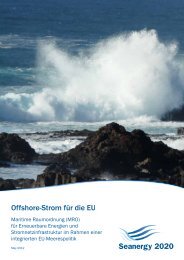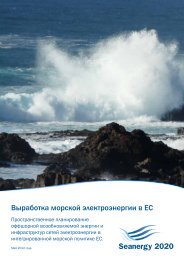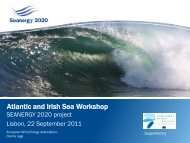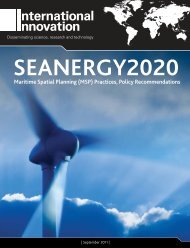Comparative analysis of Maritime Spatial Planning ... - Seanergy 2020
Comparative analysis of Maritime Spatial Planning ... - Seanergy 2020
Comparative analysis of Maritime Spatial Planning ... - Seanergy 2020
Create successful ePaper yourself
Turn your PDF publications into a flip-book with our unique Google optimized e-Paper software.
4 PERMITTING AND LICENSINGPermitting and licensing play key a role in Renewable Energy planning and implementation. In the context<strong>of</strong> <strong>Maritime</strong> <strong>Spatial</strong> <strong>Planning</strong> (MSP), permits or licences are the means whereby the overall objectives <strong>of</strong>MSP are translated into the rights and duties <strong>of</strong> individual project participants.4.1 Best practice in terms <strong>of</strong> permitting and licensing4.1.1 Guiding PrinciplesMany actions in the planning and implementation stages <strong>of</strong> Offshore Renewable Energy Projects (O-RE)projects are subject to permits and licensing and the main question is the extent to which the issue <strong>of</strong>permits is coordinated between different sectors e.g. maritime planning or electricity supply, the sectoralagencies, and between the overall objectives, in other words how streamlined and transparent is theprocess. The administrative procedures and the number and duration <strong>of</strong> permits have also beenaddressed by the WindBarriers project 10 which allows a complementary view to be taken. Furthermore, theprocess <strong>of</strong> applying for, determining and issuing permits has a cost both to the state and to individualapplicants. The extent to which permitting procedures are transparent and simple therefore gives anindication as to their relative ease <strong>of</strong> use, indirectly to the cost to applicants and e- the overall coherence <strong>of</strong>the spatial planning system.The legal framework for issue <strong>of</strong> licences or permits should be clear and efficient, but most importantly theinstitutional set-up (jurisdiction and cooperation/coordination) should be designed in a way that allows fora final decision that covers all aspects <strong>of</strong> a permit in a comprehensive, coherent, consistent andcost/effective manner.The implication <strong>of</strong> this is that the relationship between all authorities (on different levels, local, regional ornational, or sectors) involved in licensing should be well-coordinated, and the division <strong>of</strong> competencies andbetween the authorities should be clear. This is important since the underlying idea is that the overall setupshould allow for all relevant aspects/impacts <strong>of</strong> the licensing decision to be dealt with in an integratedand comprehensive manner. The evaluation reflects growing degrees <strong>of</strong> clarity <strong>of</strong> jurisdictions and theability <strong>of</strong> the system to provide for an integrated and comprehensive decision.10 The major objective <strong>of</strong> the IEE funded project, WindBarriers project (01 December 2008 – 30 November 2010) wasto obtain quantifiable data on barriers to administrative and grid access affecting the deployment <strong>of</strong> the wind energydevelopment in the EU countries. This project constituted the first attempt to systematically collect and quantifyadministrative and grid access data at EU level.Deliverable 2.319 | P a g e






